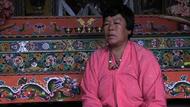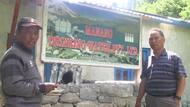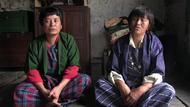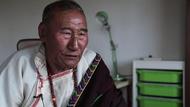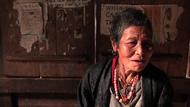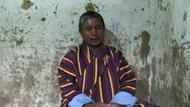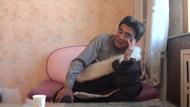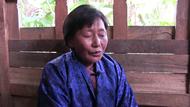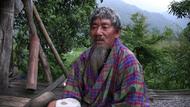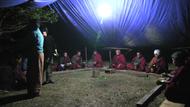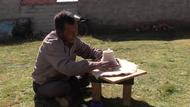Video Overview
A brief interview with a local scholar on the history of the royal tomb near Chonggyé.
- Lhokha
- Chonggyé Khül
- Chonggyé
- ཨ་ལས་དགེ་འདུན་ལགས་འདི། ག་རེ་ཟ། ཨང་བང་སོའི་ལོ་རྒྱུས་རབ་ཙམ་གསུང་རོགས་གནང་། བང་སོ་འདི་ཐོག་མ་ཐོག་མར་གང་འདྲས་བྱུང་པ་རེད། བོད་ཀྱི་བང་སོ་འདི་ག་དུས་འགོ་བཙུགས་པ་ཡིན་མིན། གང་འདྲས་བྱུང་པ་རེད། བང་སོའི་ལོ་རྒྱུས་དེ་ཅིག་གསུང་རོགས་གནང་།Well, Mr. Gedun, could you please give a brief history of the tombs by explaining how the tombs first came into being, when the Tibetan tombs were first started, etc? Anyhow, could you explain the history of the tombs?
- ཁད་བོད་ཀྱི་བང་སོའི་ལོ་རྒྱུས་ཁྱོན་ཡོངས་ནས་བཤད་པ་ཡིན་ན། བོད་ཀྱི་ད་གཙོ་བོ་བཙན་པོའི་དུས་སྐབས་ལ། ལྷག་པར་དུ་པུར་རྒྱལ་སྐབས་ལ། སྤྱི་ལོའི་སྔོན་གྱི་དུས་རབས་གཉིས་པ་ནས་ཨ་ནི་སྤྱི་ལོའི་དུས་རབས་དགུ་པའི་ཀྲག་གི་ད་པུར་རྒྱལ་དུས་སྐབས་དེའི་ནང་ལ་ཆ་བཞག་ན། ཐོག་མར་གྱི་རྒྱལ་པོ་བདུན་དེ་ཨ་ནི་ཨོང་། རྒྱལ་པོ་ཁྲི་བདུན་དེ་ཡིན་ན། ཁོང་རྣམ་ཚོའི་བང་སོ་མི་ཡུལ་ལ་མེད་ཟེ་ད། གནམ་ལ་ཕེབས་པ་ཡིན་ཟེར། དེའི་གཞུག་གི་ཨ་ནི་རྒྱལ་པོ་རྣམ་ཚོའི་བང་སོ་འདི་ཨ་ནི་ས་ཆ་ཆ་བཞག་ན། ས་ཆ་སྤང་། རིའི་སྒང་ལ་ཡོད་པ་དང་། ཨོ་མིན་ན་ཆུའི་འགྲམ་ལ་ཡོད་པ། སྤང་གི་འགྲམ་ལ་ཡོད་པ། ས་ཆ་དེའི་རོབ་བསྡུས་ཙམ་ངོ་སྤྲོད་ཞུས་པ་མ་གཏོགས། དངོས་སུ་ཨ་ནི་ས་ཆ་གང་འདྲས་ཅིག་ཡིན་མིན། ས་ཆའི་མིང་དེ་རྒྱུན་ནས་བཤད་ཡོའོ་མ་རེད།According to the overall history of the Tibetan tombs, during the time of the early Tibetan kings, particularly during the Purgyal period from 2nd century BCE upto 9th century CE, it is said that the tombs of the first seven kings, the seven Tris are not in the human world. They all went up in the sky. As for the sites of the tombs of the later kings, [the texts] only give a brief account of the places such as [the tombs] are in the mountain, or [the tombs] are on the bank of a river, and [the tombs] are near a pasture. But [they] don't explicitly mention the type of locations and the names of the places at all.
- ཁཨ་ནི་བང་སོ་དར་ཡས་དུས་སྐབས་དེ་ལ་ཆ་བཞག་ན། སྐབས་དེ་དུས་ནས་ད་དར་ཚར་པ་རེད། འདུག་ཟེར། བང་སོ་འདུག་ཟེར་མི། བང་སོར་སྦས་ཡས་དེ། ལུགས་སྲོལ་དེ་ཡིན་ན། ད་ལྟ་དེའི་འཕྱོངས་རྒྱས་དེའི་ཁུལ་དེའི་ཨ་ནི་དངོས་སུ་ད་རྒྱལ་པོ་སྲོང་། རྒྱལ་པོ་ཨོའོ། ད་བོད་ཀྱི་ད་བཙན་པོ་སྐུ་ཐོག་ཉི་ཤུ་རྩ་དགུ་ནས། ཨ་ནི་གླང་དར་མ་བར་དུ་གི་ད་རྒྱལ་རྒྱུད་ཨ་ནི་གང་ལྟར་བཅུ་གྲངས་ཅིག་གི་ད་བང་སོ་དེ་ཨ་ནི་འཕྱོངས་རྒྱས་དེའི་རྒྱུད་ལ་ཡོད་ཟེ། དེའི་ནང་ལ་ཆ་བཞག་ན། འཕྱོངས་རྒྱས་དེ་ནི་སྔོན་མ་རང་ནས་ད། པུར་རྒྱལ་སྐབས་ཀྱི་ད་ཆབ་སྲིད་དང་དཔལ་འབྱོར་གྱི་ལྟེ་གནས་ཀྱི་ས་ཆ་ཅིག་བྱས། ལྷག་པར་དུ་དེའི་རྒྱུད་ལ་ཨ་ནི། ས་ཆ་དེའི་རྒྱུད་ལ་དངོས་གནས་ཐོག་མར་ཆ་བཞག་ན། ཡར་ཀླུང་གི་ད་ཁོངས་གཏོགས་ཅིག་རེད།So, the tradition of burying tombs in this way had already become widespread by then. The tombs of ten royal lines from the 29th Tibetan King upto the King Langdarma are in the area of Chongye. In this place...Right from the beginning, Chongye was a central location for politics and economics during the time of Purgyal. Particularly in this area... This area was originally a part of Yarlung.
- ཁཡར་ཀླུང་ཟེར་འདི་ད་ང་ཚོའི་བོད་ཀྱི་བཙན་པོ་རྣམ་པ་ཚོ། རྒྱལ་པོ་སྲོང་བཙན་སྒམ་པོ་ཕན་ཆད་གི་ད་བཙན་པོ་རྣམ་པ་ཚོ་ཚང་མ་དེའི་རྒྱུད་ལ་ད་བཞུགས་བྱས་བྱས། འདི་ཡིན་ཙང་། ཁོང་རྣམ་ཚོའི་བང་སོ་དེ་ཨ་ནི་དེའི་འཕྱོངས་རྒྱས་དེར་སྦས་བྱས་འདུག་ཟེར་ཡོད། ད་ལོ་རྒྱུས་དེ་དེའི་གཙོ་བོ་ནི་ཆོས་འབྱུང་མཁས་པའི་དགའ་སྟོན་དང་། འཇིགས་མེད་གླིང་པའི་གཏམ་ཚོགས། དེ་མིན་གྱི་ད་དེབ་ཐེར་མང་པོ་ཅིག་ནང་ལ་ད་ལོ་རྒྱུས་དེ་འདྲས་འཁོད་ཡོའོ་རེད། གཙོ་བོ་བང་སོ་ལོ་རྒྱུས་ད་མདོར་བསྡུས་ཙམ་ཞིག་ཞུས་ན་དེ་འདྲས་ཅིག་རེད། ཨ་ནི་ཞིབ་ཅིག་གཟིགས་དགོས་བྱུང་ན། དངོས་སུ་ད་ཆོས་འབྱུང་མཁས་པའི་འགའ་སྟོན་དང་། ཨ་ནི་འཇིགས་མེད་གླིང་པའི་གཏམ་ཚོགས་ནང་ལ་གཟིགས་གནང་ན་ཡག་པོ་ཡོའོ་རེད།Yarlung was the place where all our early Tibetan kings starting from the King Songtsen Gampo onwards lived. That is why their tombs have been buried here in Chongye. The descriptions of [their tombs] are mentioned primarily in the Chojung Khaspai Gaton and Jigmey Lingpai Tamtsog. It is [also] mentioned in other history books. This is a brief account of the the history of the tombs. If you wanted to read it in detail, it would be good to read the Chojung Khaipai Gaton and Jigmey Lingpai Tamtsog.
- དགེ་འདུནཨ་ནི་བོད། བོད་སིལ་བུར་ཐོར་པ་རེད་པཱ། བོད་སིལ་བུར་ཐོར་པའི་སྐབས་ལ་ཨ་ནི་བང་སོ་འདི་གཏོར་བརླག་འགའ་རོའོ་༼ཆེན་༽ཕྱིན་ཡོའོ་རེད་པཱ། དེ་དུས་མང་ཆེ་བ་འདི། ད་ག་གི་འདྲ་ཅིག་འདི་བྱས་པ་ཡིན་ན། གཏོར་བརླག།And Tibet became fragmented, right? There was quite a lot of damage done to these tombs during the time of fragmentation, rigth? Which ones did you think suffered the most damage?
- ཁད་འདི་ལོ་རྒྱུས་ཐོག་ལ་འཁོད་པ་ཆ་བཞག་ན། རྒྱལ་པོ་གླང་དར་མས་གཞུག་ལ་ཨ་ནི་ད་རྒྱལ་པོ་གླང་དར་མས་ཆོས་སྣུབས་པའི་གཞུག་ལ་ད་ཨ་ནི་ལྷ་ལུང་དཔལ་གྱི་རྡོ་རྗེས་རྒྱལ་པོ་གླང་དར་མ་བསད། ད་བསད་པ་ཡིན་ཟེ། དེ་སོང་ཙང་། དེའི་གཞུག་དེའི་ཨ་ནི་ད་བོད་ཀྱི་ད་རྒྱལ་རྒྱུད་དེ་འདུག་ཟེར་བྱས་བྱས་ད་ཐོར་བྱས་བྱས། རྒྱལ་གཞིས་ད་རྒྱལ་རབས་དེ་ཐོར་ནས། ཐོར་པའི་གཞུག་ག་ལ་ད་ཡན་ལག་ད་མ་སོང་ནའི་འོད་སྲུང་དང་ཨ་ནི་ཁོ་རང་གི་ད་རྒྱལ་པོ་གླང་དར་མའི་སྲས་འོད་སྲུང་དང་ཡུམ་བརྟན་གཉིས་ཡན་ལག་ཁག་གཉིས་སུ་གྱེས་བྱས་བྱས། འདུག་ཟེར་བྱས་ནས་བོད་སིལ་བུར་ཐོར། བོད་སིལ་བུར་ཐོར་པའི་གཞུག་གུ་ཆ་བཞག་ན། ཨ་ནི་འབངས་གྱེན་ལངས་བྱས་བྱས། འབངས་ཀྱི་ད་གྱེན་ལངས་ཤུགས་ཆེན་པོ་བྱུང་བྱས། དེ་དུས་ཆ་བཞག་ན་ཨ་ནི་བང་སོ་མང་པོ་ཅིག་འཕྲོ་བརླག་ཕྱིན་པ་རེད་ཟེར་གྱིས།According to historical accounts, the King Langdarma was assassinated by Lhalung Pelgyi Dorje after he destroyed the Buddha Dharma. So, this is how the royal line got dispersed after [his assassination]. After the dispersion of the royal lineage, hmm, Ozung, the King Lang Darma's son and The Queen Mother Yumten separated into two parts, so to speak. So, this is how Tibet became fragmented. There was a revolt after the fragmentation of Tibet. So, due to this big revolt, many of the tombs suffered damage during this time.
- ཁཨ་ནི་འདི་ང་ཚོའི་ད་ལྟ་ལོ་རྒྱུས་དེའི་ནང་ལ་གཞིར་བཞག་པ་ཡིན་ན། གཙོ་ཆེ་ཤོས་ཅིག་ད་རྒྱལ་པོ་གླང་དར་མའི་བང་སོ་དེ་རྩིག་འཕྲོས་ལས་པ་རེད་ཟེར་ད། སྔོན་མ་ཐོག་མའི་འཆར་གཞི་བྱས་ན། ཆེན་པོ་རྩིག་ཡས་ཀྱི་འཆར་གཞི་ཡོད་པ་བྱས། ཡིན་ནའི་ལས་ཨ་ནི་རྒྱལ་པོ་ད་ཞེ་དྲག་བཞུགས་རྒྱུ་མ་བྱུང་བྱས། ཨ་ནི་ལྷ་ལུང་དཔལ་གྱི་རྡོ་རྗེས་བཀྲོངས་པ་སོང་ཙང་། ཕེ་གའི་ཅིག་བང་སོ་ཆུང་ཆུང་ཕེ་གི། ཕ་ན་ཆུང་ཆུང་ཨོའོ་ཕེ་གི་བཞངས་པ་ཡིན་ཟེར། བྱས་ཙང་བང་སོ་ཕེ་གི་ཨོང་འབངས་གྱེན་ལངས་ཀྱིས་འཕྲོ་བརླག་མང་པོ་བཏང་པའི། ད་དུང་ཨ་ནི་བང་སོ་དེའི་རྒྱུད་ལ་རྒྱལ་པོ་མང་པོ་ཅིག་གི་བང་སོ་ད་འཕྲོ་བརླག་བཏང་པའི་སྐོར་བཤད་ཀྱི་ཡོའོ་རེད།According to [some] historical accounts, one important thing [to know is that] the King Langdarma's tomb was left unfinished. Initially they had the plan to build a big one. But the King did not live that long, as he was assassinated by Lhalung Pelgyi Dorje. See that small tomb over there. [They] built that small one over there [for the King]. So, it is mentioned that the rebels destroyed that tomb over there and the tombs of many other kings in this area.
- དགེ་འདུནལོའོ་སོ། འབངས་གྱེན་ལངས་སྐབས་ལ།I see, during the revolt.
- ཁཨོང་། འབངས་གྱེན་ལངས་སྐབས་ལ། ཨོང་འདི་ཨ་ནི་ལོ་རྒྱུས་དེབ་ཐེར་ནང་ལ་ད་འཁོད་པའི་གསལ་ཤོས། ཁ་གསལ་ཤོས་ཅིག་གི་ད་གནས་ཚུལ་ཅིག་རེད། ཨ་ནི་འཕྱོངས་རྒྱས་རྒྱུད་ཙམ་ལ་མ་གཏོགས་བང་སོ་ཙམ་མིན་པའི་ད་དུང་ཡིན་ན་ང་ཚོའི་ད་བོད་ལ་ཆ་བཞག་ན། ད་ལྟ་ཀོང་པོའི་རྒྱུད་ལ། སྣང་རྫོང་གི་མེ་གའི་རླེབ་རི་ཟེར་འདི། བང་སོ་ད་ཚོགས་བྱས་རྒྱ་ཆེན་པོ་ཞེ་དྲག་ཡོའོ་རེད། དེ་ཡིན་ན་བཙན་པོའི་སྐབས་ཀྱི་བང་སོ་རེད་ཟེར་གྱི། ཡིན་ན་ལའི་དེའི་ནང་ལ་ད་ད་ལྟ་ཨ་ནི་རིག་དངོས་ད། གནའ་རབས་ཀྱི་ད་སྔོག་འདོན་གྱི་ལས་ཀ་བྱས་པའི་གཞུག་ལ་ག་གའི་ཅིག་དོན་ཡོའོ་མ་རེད་ད། བང་སོ་མར་གའི་ད་ཚོད་ལྟ་བལྟས་པ་རེད། མར་བསྔོགས་པ་རེད་ཏད་ཙེ། ཡིན་ན་ལའི་བང་སོ་འདི་ཚོའི་རྒྱུད་ལ་ད་ལྟ་ད་འདི་ཨ་ནི་ད་རྒྱལ་ཁབ་རིམ་པའི་རིག་དངོས་གཙོ་གནས་ཀྱི་ད་སྡེ་ཚན་གཅིག་བྱས། ཨ་ནི་དེའི་རྒྱུད་ལ་ཆ་བཞག་ན། ད་ལྟ་ཕན་ཆད་སྲུང་སྐྱོབ་བྱས་པ་མ་གཏོགས། དངོས་སུ་ད་ཚན་རིག་ཐོག་ནས་ས་འོག་ལ་མར་མིག་བལྟས་ནས་སྔོག་འདོན་དེ་འདྲས་ཀྱི་ད་ལས་ཀ་བྱས་ཡོའོ་མ་རེད། དེ་ཡིན་ན་གཙོ་བོ་རྒྱལ་ཁབ་ནས་ཆོག་མཆན་སྒུག་དགོས་གི་ཡོའོ་རེད། རེད་པ་ལགས།Yes, during the time of the revolt. And this historical event is one of the clearest descriptions mentioned in history books. Not only are there tombs in Chongye area, there is a lot more in Kongpo, Tibet. There are numbers of tombs in Lebri, in the district of Nangzong in Kongpo. It is said that they are all from the time of the early Tibetan kings. But, no material objects were dug out when [they] carried out the archaelogical work. Some experiment was done on those tombs down there. [They] dug out a little bit [for the experiment]. But this area is a part of the Culture and Artifacts department right now. It has been preserved perfectly so far. [They] have not carried out any scientific experiment by digging out, and so forth. You have to get a permission from the government in order to do that, right?
- ཁཨ་ནི་ཆེད་ལས་པ་ངེས་ཅན་ཅིག་གིས་ད་ནུས་ཤུགས་བཏོན་ནས། ཨ་ནི་ལོ་མང་པོའི་རིང་གི་ད་ལས་ཀ་དེ་བྱེད་མ་ཐུབ་ན་བསྒྲུབ་ཐུབ་ཡས་ཡོའོ་མ་རེད། རེད་པ་ལགས།There is no way that we will accomplish it if some specialists do not put their effort and work for many years, right?
- དགེ་འདུནརེད། འདི། ཨེ་ཕག་མོ་གྲུ་པའི་སྐབས་ལ་བང་སོ་དེར་སྐྱོན་ཆག་དང་དེ་འདྲས་ག་བྱུང་ཨཱ་ཡོད། སྐབས་དེ་དུས་སྔོག་འདོན་བཟོ་ལ་དེ་འདྲས་ཀྱི། སྐབས་དེ་དུས་གེའི་ཟེ་བྱུང་ཨཱ་ཡོད། འཕྱོངས་རྒྱས་ངོས་སུ་ཡོད་པའི་བང་སོ་འདི་གས་ལ།Right. Do you think that [some of the] tombs suffered some damage during the time of Phagmo Drupa? Do you think that some of the tombs around Chongye area [suffered damage] because of may be some digging out, etc. during that period?
- ཁད་དེའི་རྒྱུད་ལ་ཆ་བཞག་ན། སྐབས་དེ་དུས་ད་ཕག་མོ་གྲུ་པའི་དུས་སྐབས་ནང་ལ་ཆ་བཞག་ན། བོད་ཁྲི་འཁོར་བཅུ་གསུམ། ཐོག་མ་ཨ་ནི་ས་སྐྱའི། གཡའ་ཕག་དུས་ཟིང་ཨོང་། ཁྲི་སྐོར་བཅུ་གསུམ་བྱས། དེའི་སྐབས་ལ་ཆ་བཞག་ན། ང་ཚོ་ལྷོ་ཁའི་རྒྱུད་ལ་ད། ཁྲི་སྐོར་མང་པོ་ཅིག་ཨ་ནི་ལྷག་པར་དུ་ཨ་ནི་ཕག་མོ་གྲུ་པ། ད་གཡའ་བཟང་། ད་དུང་འདིའི་ཐང་པོ་ཆེ། དེ་ཚོ་ཨ་ནི་བོད་ཁྲི་སྐོར་བཅུ་གསུམ་གྱི་ཁོངས་གཏོགས་རེད། ཁྲི་སྐོར་དེ་འདྲས་རེད། སྐབས་དེ་དུས་ཨ་ནི་གཡའ་ཕག་འཁྲུག་པ་དང་དེ་འདྲས་ཀྱི། ཨ་ནི་ལྷག་པར་དུ་ཨ་ནི་ཨོང་། འགྲོ་མགོན་ཕག་མོ་གྲུ་པའི་དུས་ལ་ད་ད་སི་ཏུ་བྱང་ཆུབ་རྒྱལ་མཚན་གྱིས་ད་ཨ་ནི་ཡང་བོད་གཅིག་གྱུར་བཟོས་པའི་སྐབས་ལ་ཆ་བཞག་ན། ཨ་ནི་དམག་དེ་འདྲས་མང་པོ་བརྒྱབ་བྱས་བྱས། ཡིན་ན་ལའི་བང་སོ་བཏོར་པའི་ལོ་རྒྱུས་དེ་འདྲས་ཡང་གསལ་པོ་ཡོའོ་མ་རེད། དེ་འདྲས་འཁོད་ཡོའོ་མ་རེད།During the time of Phagmo Drupa in this area...Initially there were 13 throneholders under the Sakya rule. There was a conflict between Yazang and Phagmodrupa during that period. Many of the throneholders such as Phadmo Drupa, Yazang, and Thangpoche were one of those thirteen throneholders from the Lhoka region during that time. And there was a conflict between Yazang and Phagmodrupa. Particularly, when Situ Jangchub Gyaltsen unified the whole Tibet during the time of Phagmo Drupa there was a lot of fight. But, there is no clear historical record indicating any destruction of the tombs. No such destruction is mentioned.
- ཁགཙོ་བོ་འདྲ་དེ་གཡའ་ཕག་འཁྲུག་པའི་ལོ་རྒྱུས་བཤད་པ་མ་གཏོགས། ད་འདི་རང་བང་སོའི་སྐོར་གྱི་དེ་འདྲས་གནས་ཚུལ་གའི་མི་འདུག།There is a historical record of the conflict between Yazang and Phagmodrupa. Other than that there is no historical account of the destruction of the tombs.
- དགེ་འདུནལོའོ་སོ། འདི། དེའི་སྐབས་ལ་འདི་ཨེའེ། ཉེ་འཁོར་དེ་བར་དགོན་པ་བཞངས་པ་དང་། དེ་འདྲས་ཀྱི་ལོ་རྒྱུས་དེ་ཡའི་གའི་གསལ་ཡས་ཟེ་ཡོའོ་མ་རེད་པཱ།Thanks. So, it is not clear historically whether there was any construction of the monasteries going on in this surrounding area, right?
- ཁད་དགོན་པ་བཞངས་པའི་ལོ་རྒྱུས་ཡང་གསལ་པོ་ཡོའོ་རེད། དཔེར་ན་ང་ཚོའི་རྩེ་ཐང་དགོན་པ་མར་གི། ལྔ་མཆོད་སྦུག་གི་དེང་སང་རྩེ་ཐང་དགོན་པ་དེ་ཨ་ནི་། ད་དུང་ཐོག་ཨ་ནི་གདན་ས་མཐིལ་ཟེར་འདི། ཟང་རི་རྫོང་ལ་ཡོད་པའི་གདན་ས་མཐིལ་། སྐབས་དེ་དུས་ད་བཀའ་རྒྱུད་པ་ཨ་ནི་དར་རྒྱས་ཆེན་པོ་བྱུང་། བཀའ་རྒྱུད་པ་ཆོས་ཀྱི་གྲུབ་མཐའ་ལྔའི་ནང་ནས་ཆ་བཞག་ན། བཞིའི་ནང་ནས་ཆ་བཞག་ན། བཀའ་རྒྱུད་པ་དེ་ནི་ང་ཚོ་ལྷོ་ཁའི་རྒྱུད་ལ་ཆ་བཞག་ན་ཧ་ཅང་གི་དར་ཆེན་པོ་བྱས། ལྷག་པར་དུ་ཨ་ནི་ཕག་མོ་གྲུ་པ་དེ། ཨ་ནི་གཙོ་བོ་ད་ཆེ་བཞི་ཆུང་བརྒྱད། ཆུང་བརྒྱད་ཀྱི་ཁོངས་གཏོགས་ད་མ་དགོན་དེ་འདྲས་འདྲ་ཅིག་རེད།Well, there is a clear historical record of the construction of monasteries. For instance, Tsethang monastery, the one in Ngachog, and Dhensathil in the district of Zangri [were built during that time.] The Kagyu sect was very widespread during that period. Among the five or four Tibetan sects the Kagyu sect became extremely widespread in our Lhokha region. Phagmo Drupa was particularly... Within the Four Major and Eight Minor Kagyu sects [these monasteries] are a part of the Eight Minor Kagyu sects.
- དགེ་འདུནལོའོ་ལོའོ། ལོའོ་ལོའོ། འདི་སྐབས་ལ་དེ་ནི་གཞུག་གུ་དེ་དགའ་ལྡན་ཕོ་བྲང་སྐབས་ལ་རེད་པཱ། བོད་ས་གནས་སྲིད་གཞུང་སྐབས་ལ། ཨ་དེ་དུས་སྔོག་འདོན་དང་དེ་འདྲས་གའི་བྱུང་ཡོའོ་མ་རེད་པཱ།Thanks. What about during the time of the Gaden Phodrang (the name of the Tibetan government)? Was there any digging up, etc. going on under the rule of the Tibetan government?
- ཁཨོང་། ད་དེ་དུས་ཀྱི་ད་ལོ་རྒྱུས་ནང་ལ་ད། ཨོང་དེ་འདྲས་སྔོན་འདོན་ད་ཞེ་དག་བྱུང་ཡོའོ་མ་རེད། ལྷག་པར་དུ་བང་སོ་འདིའི་རྒྱུད་ལ་ད་སྲུང་སྐྱོབ་ཡག་པོ་ཞེ་དྲག་ཐོབ་པའི། ཨ་གཅིག་ནས་ཨ་ནི་སྲོང་བཙན་སྒམ་པོའི་བང་སོ་དེའི་སྒང་དེའི་སྔོན་མ་གི་བང་སོ་ཀྲུང་མཁན་༼སྲུང་མཁན༽གྱི་མི་ཨེ་འདྲས་བསྡད་ས་གཅིག། གཞུག་ལ་ད་ཕར་ལྷ་ཁང་འདུག་ཟེར་བསྒྱུར་བྱས་བྱས། དེའི་སྒང་ལ་བཞུགས་ས་ཡོད་པ་བྱས། ལྷག་པར་དུ་ཨ་ནི་དངོས་སུ་བོད་ས་གནས་སྲིད་གཞུང་གི་ཆ་བཞག་ན། དེའི་སྒང་ལ་གཙོ་གནས་ལྷག་པར་དུ་སྲོང་བཙན་སྒམ་པོའི་བང་སོ་དེ་ལ་ཡིན་ན། ལྕགས་རི་ཕྱི་ནང་གསུམ་བསྐོར་བྱས། འདིའི་སྒང་དེ་མི་བཞུགས་མཁན་ཡོད་པ། ཨ་ནི་དེ་མིན་བང་སོ་གཞན་དག་ལ་དོ་དམ་བྱེད་མཁན་དེ་འདྲས་ཅིག་ཡོད་པ་བྱས། ཨ་ནི་ལོ་རྒྱུས་དེབ་ཐེར་ནང་ལ་ཆ་བཞག་ན། དེབ་ཐེར་ནང་ལ་བཤད་སྲོལ་ཡིན་ནའི་འདྲ། བཤད་སྲོལ་ཡིན་ནའི་ནང་ལ། བང་སོ་ལ་ད་གནོད་སྐྱོན་བྱུང་པའི་གའི་སྐོར་ཡོའོ་མ་རེད།Well, there was no story of such digging up, etc during that period. [It is mentioned that] the tombs in these areas received special protection. There used to be a watchtower for the tomb-guard over the King Songtsen Gampo's tomb before. And it was later turned into a temple. Yes, there was a watchtower over [Songtsen Gampo's] tomb. Particularly during the time of the Tibetan government there were three rounds of fences put around the King Songtsen Gampo's tomb in particular. There was a tomb-guard [watching over the tomb during this time.] And there were caretakers of the other tombs also [during that period.] So, there is no mention of any damage to these tombs either in the history books or any documents.
- ཁསྤྱིར་བཏང་བྱས་ན་ད་འདི། གཞུག་ལ་ཕྱིས་བྱུང་ལ། ཨེ་བོད་ས་གནས་སྲིད་གཞུང་སྐབས་ལ་ཆ་བཞག་ན། ཕལ་ཆེར་དེ་ཙམ། ད་སྔོག་འདོན་དང་དེ་འདྲས་བྱུང་། བྱས་མེད་པ་འདྲ།Generally speaking, it seems like there was not that much excavation going on during the time of the Tibetan government.
- དགེ་འདུནལོའོ་ལོའོ་ལོའོ། ཨ་ནི་དེ་ནས་ད་ལྟའི་ངོས་ནས་བྱས་ན། འཆར་གཞི་འདྲ་པོ་ཅིག་གང་འདྲས་གང་འདྲས་ཡོད་ན།Okay. What are some of the plans now?
- ཁད་ལྟ་རྒྱལ་ཁབ་ཀྱི་ད་ཁྱོན་ཡོངས་ནས། གཙོ་བོ་སྲུང་སྐྱོབ་བྱེད་ཡས་དེ་ཚོ་ཨང་དང་པོ་བྱས། སྲུང་སྐྱོབ་དེ་གང་འདྲས་བྱེད་དགོས་ཟེར་ན། སྔ་མ་ད་བང་སོ་དེའི་གཡས་གཡོན་ལ་ཆ་བཞག་ན། ལྕགས་རི་ཡོད་པ་ཡིན་ནའི་འདྲ། མཐའ་ལྕགས་རི་བསྐོར་ནས། ཨ་ནི་གཡས་གཡོན་ཞིང་ཁ་དེ་འདྲས་ཡིན་ན་ཟེར་ནའི་ལའི། ཁོ་རའི་བང་སོའི་གཡས་གཡོན་ཁོ་རེ་རྒྱ་ཁྱོན་ངེས་གཏན་ཅིག་བཞག་ནས། ཆུ་དང་དེ་འདྲས་ཅིག་གི་ཆུ་རིས་མི་འགྲོ་ཡས་དང་། ཆུ་ད་ཅི་དག་མ་འཛུལ་པ། ཨ་ནི་དེ་འདྲས་ཅིག་སྲུང་སྐྱོབ་བྱེད་ཡས་ཀྱི་ཆེད་དུ་བྱ་ཐབས་སྣ་ཚོགས་སྤེལ་གྱི་ཡོའོ་རེད།The first and the foremost [plan] of the government is to protect the tombs. Previously there were fences surrounding the tombs. [Now the government] is taking all these initiatives such as leaving a certain distance between the tombs and agricultural fields so that water does not seep into the [tombs], etc.
- ཁད་གཙོ་ཆེ་ཤོས་རྒྱལ་ཁབ་རང་ནས་འགྲོ་སོང་ངེས་གཏན་ཞིག་གཏང་ནས་ད་ཁྱོན་ཡོངས་ནས་ད་ད་ལྟ་ཨ་ནི་གཙོ་ཆེ་ཤོས་སྲུང་སྐྱོབ་ཐབས་ཤེས་སྣ་ཚོགས་གཏིང་ཡས་ཀྱི་ད། ཆུ། ཆི་འདི་སྔོན་འགོག་བྱེད་ཀྱི་ཡོའོ་རེད་ད། གཙོ་ཆེ་ཤོས་ཆུ་འདི་སྐོར། གནས་ཚུལ་དར་རྒྱས་གཏོང་ཐོབ་ཡས། ཐབས་ཤེས་ཞེ་དྲག་གཏང་གི་ཡོའོ་རེད། གཙོ་ཆེ་ཤོས་འདི་རེད། ཡིན་ན་ལའི་སྔོག་འདོན་བྱེད་ཡས་དང་དེ་འདྲས་ཀྱི་འཆར་གཞི་དེ་འདྲས་ད་ལྟ་ཡག་པོ་ཡོའོ་མ་རེད།The government is spending a certain amount of money to pay particular attention to the protection [of the tombs], particularly for the prevention of water. [The government] is taking all these initiatives to make progress on the water [problem]. This is the most important. But, there is no such plan to do any excavation, etc. right now.
- དགེ་འདུནའདི་ག་རེ་ཟགས། ཞིབ་འཇུག་བྱེད་ཡས་དང་དེ་འདྲས་ཀྱི་འཆར་གཞུ་ཟེ་གའི་ཡོའོ་མ་རེད་པཱ་ལགས།Well, there is no plan to carry out any research, etc. right?
- ཁཡོའོ་མ་རེད་ལགས། ད་གཙོ་ཆེ་ཤོས་དེ་སྔོག་འདོན་གཅིག་པུའི་ཐོག་ནས། ད་ཞིབ་འཇུག་བྱེད་ཡས་ཟེར་ནའི། ང་ཚོས་ད་ལྟ་ལོ་རྒྱུས་དེབ་ཐེར་རང་ལ་བལྟས་ན། ཞིབ་འཇུག་བྱེད་ཡས་མ་གཏོགས། དངོས་སུ་ས་འོག་ལ་གང་འདྲས་ཡོད་མེད་བལྟས་དེ་འདྲས་བྱས་ཡོའོ་མ་རེད། ད་ཨཱ་ལའི་གནས་སྐབས་མཚམས། ཡིན་ནའི་ཕྱིས་བྱུང་ཆ་བཞག་ན། ད་རྒྱལ་ཁབ་ཀྱི་ད་འཆར་གཞི་ངེས་གཏན་བཟོས་ནས། ཨ་ནི་ཕལ་ཆེར་ཡོང་དོག་ཁ་པོ་རེད་པཱ་ལགས།No, [there is no such plan.] Well, doing excavation is not the only way to do research. We have done our research only by reading some historical documents, we have not done any excavation to see what lays underneath the ground. However, in future this could happen if the government would make a certain plan. What do you think?
- དགེ་འདུནལགས་རེད། ལགས་རེད། ལོ་རྒྱུས་སྒང་ལ་བང་སོ་དེ་གས་གང་ག་ལོག་ལ་སྔོག་འདོན་སྤྱིར་བཏང་བྱས་མྱོང་ཨཱ་ཡོད། ཡོད་ཀྱི་མ་རེད་པཱ་ལགས། འབངས་གྱེན་ལོག་སྐབས་ལ་ཏད་ཙེ་རྒུད་ཆག།I agee. I wonder whether these tombs have ever been excavated throughout the history. Probably not, right? They might have suffered some damage during the revolt.
- ཁའབངས་གྱེན་ལོག་སྐབས་ལ་རྒུད་ཆག་བྱུང་པ་བྱས། ཡང་དེའི་གཞུག་ལ་ཡང་གང་ལྟར་བོད་སིལ་བུའི་དུས་སྐབས་ནང་ལ་ཆ་བཞག་ན། དུས་ཚོད་ད་ཕན་ཆད་ལ། བང་སོ་བཙུགས་ནས། བང་སོ་འདི་བརྒྱབ་པའི་དུས་སྐབས་ལ་ཆ་བཞག་ན། སྤྱིར་བཏང་སྤྱི་ལོའི་དུས་རབས་བཞི་པ་ཙམ་ནས་དྲུག་པ། ཨེ་འདི་གང་ཟགས། ཨེའེ་ལྔ་པ་དྲུག་པ་ཙམ་ནས། དུས་རབས་དགུ་པ་དེ་བར་དུ་ཨ་ནི་འདི་ནང་ནས་ཨ་ནི་ད་ཕན་ཆད་ཆ་བཞག་ན་ལོ་གཅིག་སྟོང་ལྷག་ཙམ་ཅིག་ལོ་རྒྱུས་ཡོའོ་རེད་པཱ་ལགས། གཅིག་སྟོང་གསུམ་བརྒྱ་ལྷག་ཙམ་ཅིག། དེའི་ནང་ཁུལ་ལ་ཆ་བཞག་ན། ད་གཙོ་ཆེ་ཤོས་གཅིག་འབངས་གྱེན་ལོག་གཅིག་གསལ་པོ་འཁོད་ཡོའོ་རེད། དེ་ནས་ཨ་ནི་ད་དུང་བོད་ཀྱི་ཆ་བཞག་ན་ད་དཔེར་ན་ས་སྐྱའི་དུས་སྐབས་ཡིན་ནའི་འདྲ། ཕག་མོ་གྲུ་པའི་དུས་སྐབས་ཡིན་ནའི་འདྲ། དེ་དུས་སྐབས་ལ་ཆ་བཞག་ན། སྔོག་འདོན་བྱས་པའི་ལོ་རྒྱུས་བཤད་སྲོལ་ད་དེའི་ནང་ལ་གསལ་པོ་འཁོད་ཡོའོ་མ་རེད་དེ། ཡིན་ནའི་ལའི་ཨ་ནི་སྐྱོན་ཆགས་དེ་མང་པོ་ཞེ་དྲག་བྱུང་ཞག།They suffered some damage during the revolt. And later during the Fragmentation Period of Tibet...until now... As for the period when these tombs were made, they were made in the time period between 4th and 6th century...no, [they were made] between 4th or 5th centuries and 9th century. So, there is a history of more than 1000 years, right. [There is a history of] over 1300 years. The commoners' revolt is particularly mentioned in the [history of] this period. Even though there is no clear mention of excavation being carried out either during the time of Sakya rule or during the time of Phagmo Drupa in Tibet, [the tombs] suffered some great damage.
- ཁབང་སོ་མཐོ་ཤོས་ཡ་གའི་མཚམས་ཡ་གའི་ཨ་ནི་དཀྱིལ་དེར་སྔོག་འདོན་དོང་ཀོང་སྟོང་༼གཏིང་༽རིང་པོ་བྲུས་བྱས་བསྔོག་བཞག།See that highest tomb over there. [Some people] gouged a big hole in the centre.
- དགེ་འདུནལོའོ་སོ། དེ་ག་དུས་ཡིན་མིན་ཧ་གོ་ཡོའོ་མ་རེད་པཱ།I see. But, we don't know when it happened, right?
- ཁའདི་དུས་ཚོད་ལོ་ག་དུས་ཡིན་མིན་ཧ་གོ་ཡས་ཡོའོ་མ་རེད།There is no way to know when it happened.
- དགེ་འདུནལོའོ་ལོའོ། ཨ་ནི་ད་གིན་རྡོ་ཡི་སེང་གེ་གཉིས་ཡོའོ་རེད་གསུངས་ཡས་དེ་ཕ་གིའི་སྒང་ལ་རེད། རེད་པཱ་ལགས།Thanks. The two snow lions that you mentioned earlier are over there, right?
- ཁཨོའོ་ད་རྒྱལ་པོ་ལྗང་ཚ་ལྷ་དབོན་གྱི་བང་སོའི་སྒང་དེ། ཁོང་རང་གི་ཡབ་ཁྲི་ལྡེ་གཙུག་ལྡན་གྱི་བང་སོའི། ད་རྒྱལ་པོ་ཁྲི་ལྡེ་གཙུག་ལྡན་གྱི་ད་བང་སོའི་གཡས་དང་གཡོན་དེ་ད་སེང་གེ། རྡོའི་སེང་གེ་ཕོ་མོ་རེ་རེ་ཡོའོ་རེད། ཕོ་གཅིག་དང་མོ་གཅིག་ཡོའོ་རེད།Above the King Gyangtsa Lhawon's tomb is his father Khrideh Tsugden's tomb. And there is a sculpture of a male snow lion and a sculpture of a female snow lion on the King Trideh Tsugden's left and right sides. There is one male snow lion and one female snow lion.
- དགེ་འདུནཕོ་གཅིག་དང་མོ་གཅིག། ལོའོ་ལོའོ། ཨ་ནི་བང་སོ་ངོས་འཛིན་བྱེད་ཡས་དེ་ལ་སྤྱིར་བཏང་བྱས་ན། གཅིག་འགྱུར་འདྲ་ཅིག་རེད། རེད་པཱ་ལགས།One male snow lion and one female snow lion. Thanks. In terms of the identification of the tombs it is all the same, right?
- ཁཨོང་། ད་ང་ཚོས་ད་ལྟ་ངོས་འཛིན་ཞུ་ཡས་འདི་གཙོ་ཆེ་ཤོས་ད་ཨོང་འཇིགས་མེད་གླིང་པའི་གཏམ་ཚོགས་དེ་གཙོ་བོ་ངོས་འཛིན་བྱས། ཨ་ནི་དེའི་སྒང་དེའི་ད་དུང་ད་ཆོས་བྱུང་མཁས་པའི་དགའ་སྟོན་ནང་ལ་ངོ་སྤྲོད་གནང་པ་གཞིར་བཞག་བྱས་བྱས་ངོས་འཛིན་བྱེད་ཀྱི་ཡོའོ་རེད། སྤྱིར་བཏང་བྱས་ན་ད་ངོས་འཛིན་བྱེད་ཡས་དེ་འདུག་ཟེར་དེབ་ཐེར་དེ་ཚོ་དང་ཕར་ཚུར་ཚད་བསྡུར་བྱེད་དུས་འདྲ་པོ་འདྲ་པོ་འདྲ་བསྡད་ཀྱི་ལགས། ཡིན་ན་ལའི་ཆུང་ཙག། བང་སོ་ཆུང་ཙག་ཁག་ཅིག་ཨ་ནི་ད་ལྟ་སུ་གི་བང་སོ་ཡིན་མིན་རྒྱུན་ནས་ངོ་ཤེས་ཀྱི་མི་འདུག། ད་འདི་དཀའ་ལས་ཁག་པོ་རེད་ཞག།Well, our identification [of the tombs] is based primarily on Jigmey Lingpai Tamtshog. In addition to that we [also] base our identification on the explanations given in Choejung Khaipai Gaton. Generally speaking, when we compare these different books with one another they all seem to agree [on the identification.] However, as for some of the small tombs, we do not know whose tombs they are. These are very difficult [to identify.]
- དགེ་འདུནཨ་ནི་ལྷ་ཁང་འདི་འདི་སྲོང་བཙན་བང་སོ་མིན་པའི་གཞན་དག་སྒང་འདི་བར་ལྷ་ཁང་ཡོའོ། ཡོའོ་མ་རེད་པཱ།So, there is no temple over any other tombs beside Songtsen Gampo's tomb, right?
- ཁཡོའོ་མ་རེད། ད་འདི་བང་སོ་གཞན་དག་སྒང་ལ། ལོ་རྒྱུས་སྒང་ལ་ཡིན་ན། བང་སོ་དེ་ཚོའི་སྒང་ལ་ལྷ་ཁང་ཡོད་པ་དེ་འདྲས་གཅིག་ཡའི་འཁོད་ཡོའོ་མ་རེད། ཡིན་ནའི་ལའི་ཕ་གའི་ད་མི་ཚང་གཅིག་ཡོའོ་རེད་ད། བཤད་པ། ཤར་པ་ཟེར་ཅིག་མི་ཚང་གཅིག་ཡོའོ་རེད། སྔན་མ་ཁྲལ་པའི་ཁྱིམ་ཚང་གཅིག་རེད་ཟེར་གྱིས། མི་ཚང་ཨོའོ་ཕ་གི་བང་སོའི་སྒང་ལ་ཡོའོ་རེད། ཨོའོ་དེ་འདྲས་གཅིག་རེད། ཨོང་།Right. It is not mentioned at all in history books that there is a temple over other tombs. However, there is a family right over there. The name of the family is Sharpa. It is said that they used be a taxpayer family in the past. So, that family is over a tomb. That is one case.
- དགེ་འདུནབང་སོ་དེ་ག་གིའི་བང་སོ་ཡིན་མིན་ཧ་གོ་ཡས་ཡོའོ་མ་རེད་པཱ།So, we don't know whose tomb it is, right?
- ཁད་འདི་ཧ་གོ་ཡས་མི་འདུག། མུ་རུབ་བཙན་པོའི་བང་སོ་རེད་ཟེར་གིས། ཡང་མུ་ཏིག་བཙན་པོའི་བང་སོ་ཡའི་ཡིན་ཟེར་གིས། ད་འདི་གསལ་པོ་ཞེ་དྲག་མིན་འདུག།Yes, we don't know. Some say that it is king Murub Tsenpo's tomb. And some say that it is king Mutig Tsenpo's tomb. It is not that clear.
- དགེ་འདུནལོའོ་ལོའོ། ཨ་ནི་ཁྱེད་རྣམ་ཚོའི་འདི་འཕྱོངས་རྒྱས་ཀྱི་ཡུལ་སྐད་ལ་ཀྲོང་བཙན་གསུང་གི་འདུག་ག། ཀྲོང་བཙན་གསུང་ཡས་དེ་སྤྱིར་བཏང་། བང་སོ་བང་སོ་ཟེར་གྱི་མ་རེད་པཱ། ཀྲོང་བཙན་གསུང་གི་རེད། རེད་པཱ་ལགས།Thanks. You guys use the term 'trong tsen' [for tomb] in your Phyongye dialect. [Any reasons] for using this term 'trong tsen'? You guys don't say 'bang so' [for tomb], right? You say 'trong tsen,' right?
- ཁཨོང་། ད་འདི་གཙོ་བོ་ལྷ་ཁང་དེར་ཟེར་གྱི་ཡོའོ་རེད། ཀྲོང་བཙན་ལྷ་ཁང་ཟེར་གྱི་ཡོའོ་རེད། ད་ཀྲོང་བཙན་དང་སྲོང་བཙན་ཟེར་ང་ཚོའི་བོད་ཡིག་གི་འབྲི་ཚུལ་ཅིག་རེད་མ་གཏོགས། ང་ཚོས་ཀྲོ་མ་ཟེར་ཡག་འདི་དང་སྲོ་མ་ཟེར་ཡག་འདི་གཅིག་པ་རེད་པཱ། ཨ་ནི་ད་ག་ནང་བཞིན་ཀྲན་མ་དང་སྲན་མ་ཟེར་ཡག་འདི་གཅིག་པ་རེད། སྟོན་ཏོག་ཀྲན་མ་དང་སྲན་མ། ཨོང་། ང་ཚོས་དེར་ཀྲོང་བཙན་ཟེར་ཡས་དེ་ད་ག་ནང་བཞིན་རེད། སྲོང་བཙན་ཟེར་ནའི་འགྲིག་གི་ཡོའོ་རེད་ལ། ཀྲོང་བཙན་ཟེར་ནའི་འགྲིག་གི་ཡོའོ་རེད། གཅིག་པ་རེད། ད་སྲོང་བཙན་ད། སྲོང་བཙན་སྒམ་པོའི་ད་ཕོ་བྲང་དེ་བང་སོ་ཡེ་གའི་སྒང་གི་ད་སྲོང་བཙན་ལྷ་ཁང་ཟེར་གྱི་ཡོའོ་རེད།Well, it refers primarily to the temple, the Trongtsen temple. The words 'trong tsen' and 'song tsen' are just a matter of difference in writing variation. Except for that [there is no difference.] As you know, the words 'tro ma' and 'so ma' are the same. Similarly, the words 'tren ma' and 'sen ma' are the same. I am referring to the bean 'tren ma' or 'sen ma.' It is the same reason why we call this temple 'Trongtsen.' You can call it either 'Trongtsen' or 'Songtsen.' It is the same. The one on top of Songtsen Gampo's tomb is Songtsen temple.
- དགེ་འདུནཨ་ལས། ཀྲོང་བཙན་ཟེར་ཡག་འདི་ལྷ་ཁང་གཅིག་པོར་མ་གཏོགས་གཞན་དག་ལ་གོ་གི་ཡོའོ་མ་རེད་པཱ་ལགས།I see. So, 'trong tsen' refers only to the temple, not others, right?
- ཁགཞན་དག་ལ་གོ་གི་ཡོའོ་མ་རེད།It does not refer to anything else.
- དགེ་འདུནགཞན་དག་ལ་བང་སོ་རང་ཟེར་གྱི་རེད། རེད་པཱ་ལགས།You use the word 'bang so' for others, right.
- ཁབང་སོ་ཟེར་གྱི་རེད། ཨོང་།Yes, we use the term 'bang so' for [tombs.]
- དགེ་འདུནཨཱ་ལས། ལོའོ་ལོའོ།I see. Thank you.
 Loading ...
Loading ... 